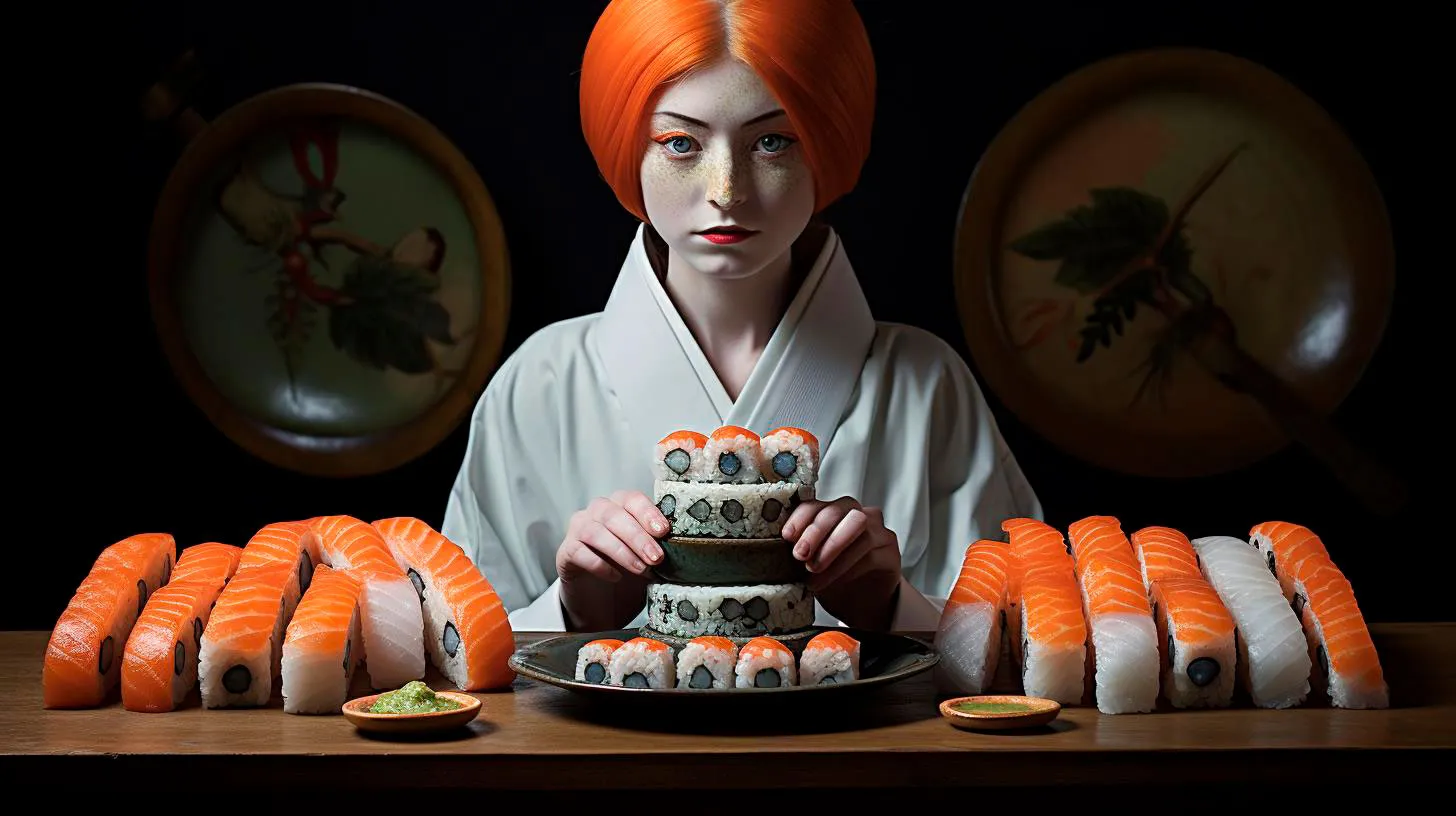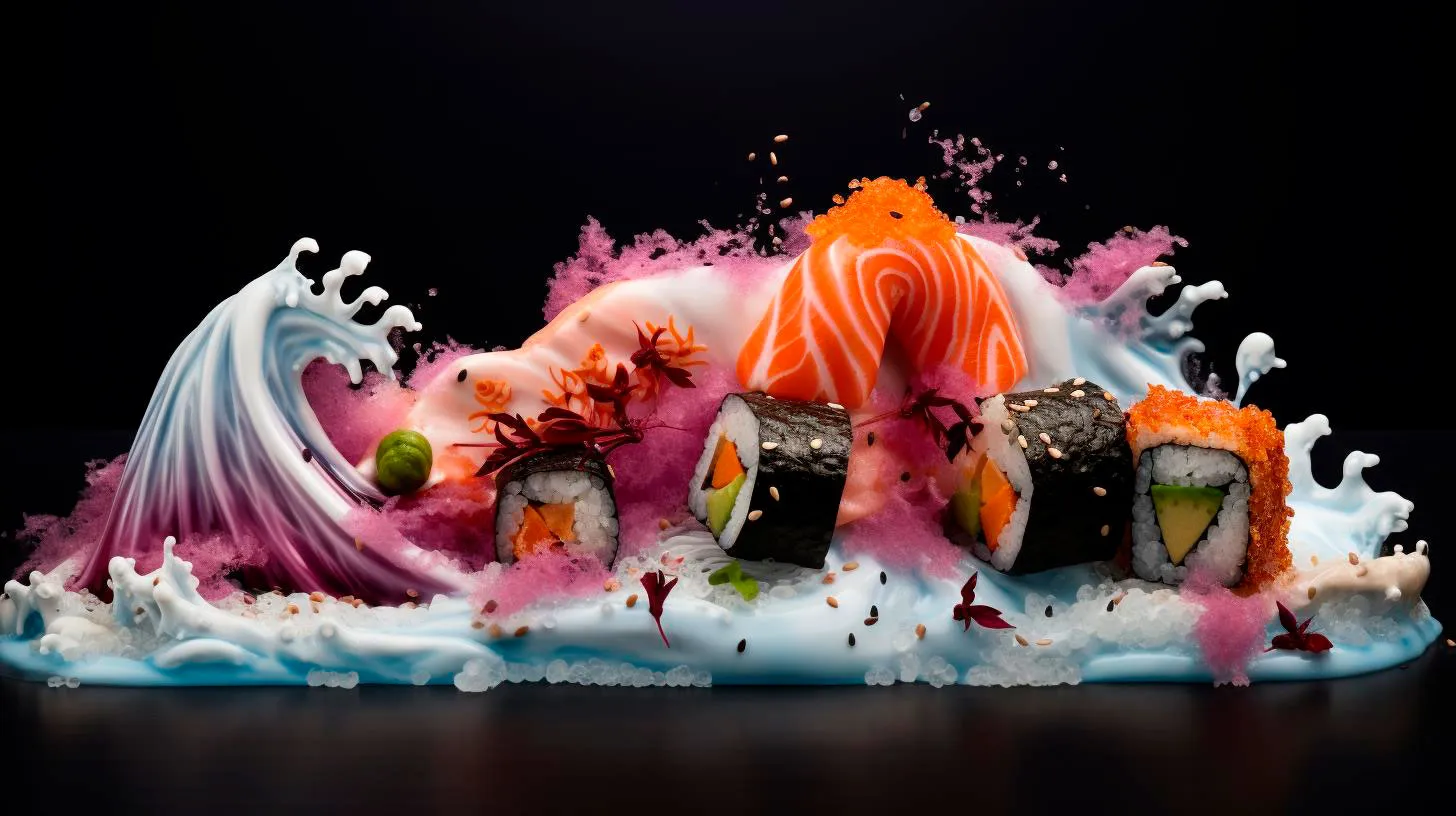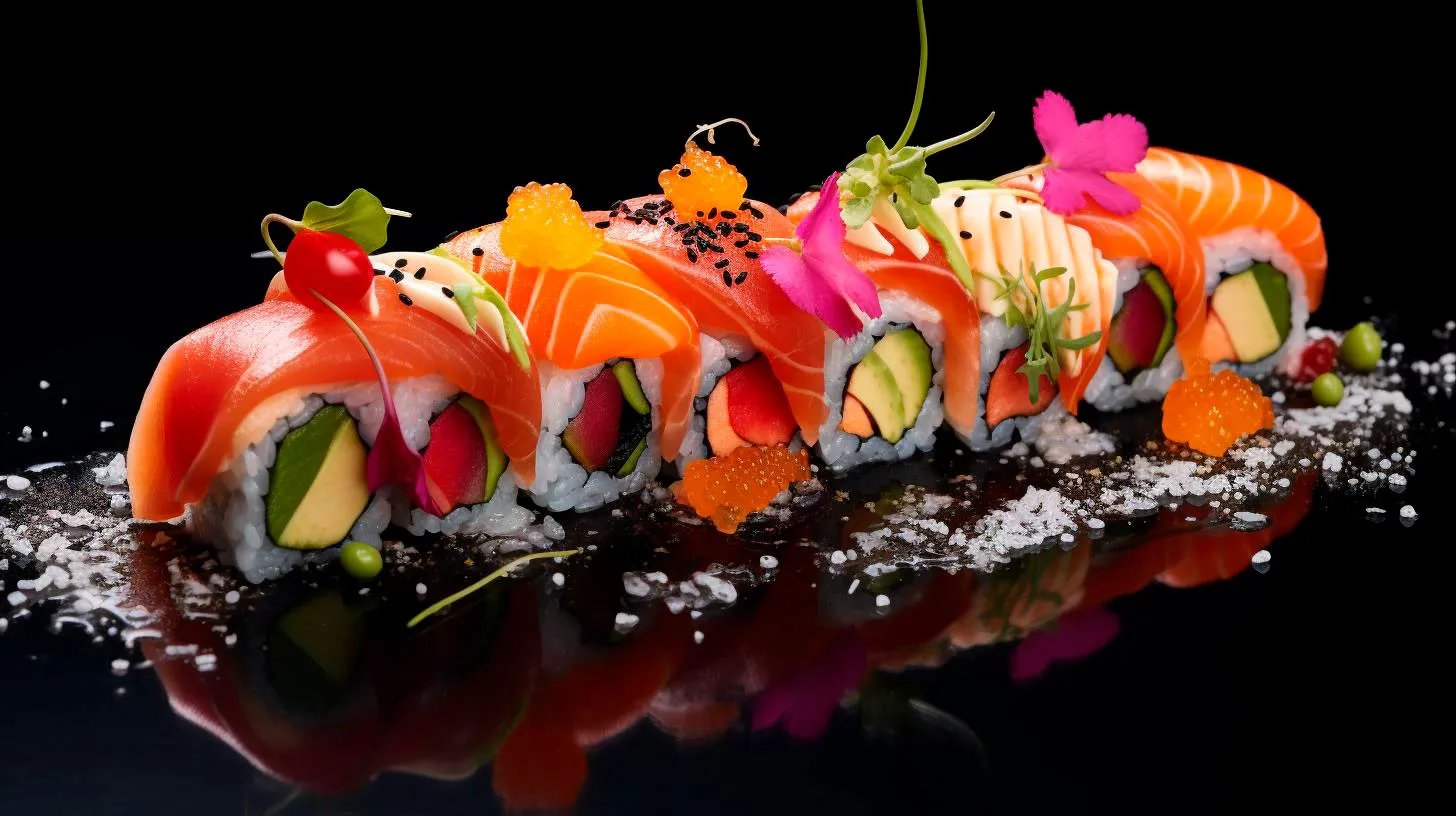The Origins and Evolution of Sushi: A Delectable Journey Through Time
Join us on a delectable journey through time as we explore the rich history and unique evolution of this iconic dish.
The Birth of Sushi: Ancient Beginnings
The history of sushi can be traced back nearly 1,300 years ago to Japan. However, its origins can be found even further back, in Southeast Asia. The concept of preserving fish in fermented rice was introduced to Japan by Chinese immigrants during the 8th century. Known as narezushi, this early form of sushi was made by fermenting salted fish with rice and letting it cure for several months. The rice was discarded, and only the fish was consumed.
- Key takeaway: The ancient form of sushi, narezushi, involved fermenting fish with rice.
Over time, the Japanese developed a new method of preserving fish that didn’t involve fermentation. They began to cure fish with vinegar and salt, which helped to preserve its freshness. This marked the birth of a new style of sushi called haya-zushi. During the Muromachi period (1336-1573), haya-zushi gained popularity as a quick and portable snack for travelers. The vinegar used in this style of sushi acted as a natural preservative, allowing people to enjoy fresher-tasting fish.
- Key takeaway: Haya-zushi, the predecessor of modern sushi, was developed during the Muromachi period.
The Emergence of Edo-Mae Sushi: A Shift in Paradigm
In the early 19th century, a significant shift occurred in the world of sushi. During the Edo period (1603-1868), sushi underwent a remarkable transformation that would shape its future. The development of a new type of sushi called nigiri-zushi revolutionized the way sushi was prepared and served.
Nigiri-zushi, meaning “hand-formed sushi,” introduced the concept of combining vinegared rice with bite-sized slices of fish. This style of sushi elevated the dining experience by emphasizing the quality of the ingredients, delicate craftsmanship, and the art of presentation. Chefs meticulously shaped each piece of nigiri-zushi by hand, showcasing their skill and attention to detail.
- Key takeaway: Nigiri-zushi is a style of sushi that combines vinegared rice with bite-sized slices of fish.
The Edo period also saw the emergence of the world’s first sushi restaurants. These establishments, known as sushiya, attracted customers from all walks of life. Sushiya revolutionized the dining experience, offering a space dedicated solely to sushi. The chefs behind the counters showcased their expertise and creativity, introducing new flavors and combinations.
- Key takeaway: The Edo period marked the emergence of sushi restaurants, introducing new flavors and combinations.
Sushi Goes Global: Spreading the Culinary Delight
As sushi gained popularity in Japan, it caught the attention of international travelers and eventually reached foreign shores. In the mid-20th century, the United States embraced sushi, marking the beginning of its global journey.
Although initially met with skepticism, sushi eventually captivated the Western palate. With its emphasis on freshness, health benefits, and visually appealing presentation, sushi became a culinary sensation. Americans quickly developed a taste for traditional nigiri-zushi, maki rolls, and sashimi.
- Key takeaway: The United States played a crucial role in popularizing sushi globally.
With the globalization of sushi came innovative adaptations and fusion cuisines. Chefs in various countries began to experiment with local ingredients, creating unique rolls and flavor combinations. From California rolls to spicy tuna and tempura rolls, sushi took on new forms, incorporating international flavors to suit diverse tastes.
- Key takeaway: Sushi has evolved globally to incorporate diverse ingredients and flavors.
The Modern Sushi Experience: A Fusion of Tradition and Innovation
Today, sushi continues to evolve, melding tradition with innovation. From traditional sushi bars to conveyor belt sushi restaurants, the culinary landscape offers a myriad of options for sushi aficionados.
Advancements in technology have also influenced the sushi industry. Sushi-making robots have emerged, streamlining the process and ensuring consistency in quality. Additionally, the rise of online food delivery services has made sushi accessible to a wider audience, with the convenience of enjoying it in the comfort of one’s own home.
- Key takeaway: Technology has revolutionized the sushi industry, making it more accessible and efficient.
As we look to the future, sushi is poised to continue its journey of evolution and adaptation. With the growing focus on sustainability and plant-based diets, we can expect to see more vegan and environmentally-friendly sushi options. The fusion of traditional Japanese techniques with modern culinary trends will undoubtedly shape the future of sushi.
Conclusion
Sushi’s origins can be traced back to ancient times, where it emerged as a preservation method in Southeast Asia. From its humble beginnings, sushi has evolved into a global culinary phenomenon, showcasing the craftsmanship and creativity of chefs around the world.
Whether you prefer the traditional artistry of nigiri-zushi or the innovative rolls of fusion cuisine, sushi offers a truly delectable journey through time. Embrace the rich history, indulge in the diverse flavors, and savor every bite as sushi continues to captivate and delight.
Celebrating Traditions: How Sushi Plays a Central Role in Japanese Festive Culture
In this article, we delve into the fascinating connection between sushi and Japanese cultural celebrations, exploring its roots, symbolism, and the role it plays in various festivities.
The Origins of Sushi in Japanese Festivals
Sushi, a widely recognized Japanese dish globally, actually has its origins in Japanese rituals and festivals. Originally, sushi was a way to preserve fish by fermenting it with rice. This preservation method was highly valued during religious ceremonies and celebrations, where spoilage was a concern. Over time, sushi evolved to be more palatable and aesthetically pleasing, making its way into everyone’s hearts and eventually becoming an indispensable part of Japanese festival culture.
Key takeaways:
- Sushi originated as a method of fish preservation during religious ceremonies and festivals.
- It has evolved to become a beloved delicacy enjoyed by many.
- Its significance in Japanese festivals persists to this day.
Sushi Symbolism in Festive Culture
Sushi, beyond its culinary creation, holds symbolic meanings that make it a perfect addition to Japanese festivities. For example, the use of various ingredients in sushi represents different aspects of nature and seasons. In spring festivals, you may find sushi filled with fresh and vibrant ingredients like sakura leaves and cherry blossoms, symbolizing the arrival of a new season. Similarly, during autumn celebrations, sushi often incorporates seasonal vegetables and fish, honoring the harvest and the changing colors of foliage.
The presentation of sushi is also symbolic. Each ingredient is carefully selected and arranged to reflect the beauty of nature, resembling an edible artwork. The colorful and intricate designs of sushi plates not only please the palate but also appeal to the eyes, creating a sense of celebration and enjoyment.
Key takeaways:
- Sushi ingredients reflect nature and the changing seasons.
- Sushi presentation resembles an edible artwork.
- Sushi’s visual appeal adds to the festive atmosphere.
Sushi in Traditional Festivals
Sushi plays a central role in many traditional Japanese festivals. One prominent example is the famous Tango no Sekku, also known as Children’s Day. Celebrated on May 5th, families often enjoy a special type of sushi called chirashizushi, which consists of colorful ingredients like diced fish, vegetables, and omelet atop a bed of sushi rice. The vibrant colors and assortment of toppings represent happiness, good fortune, and a prosperous future for children.
Another major festival where sushi steals the spotlight is the Ohara Naked Festival in Kyoto. To celebrate this event, sushi rolls called makizushi are traditionally made in abundance. The cylindrical shape of makizushi symbolizes the wish for a good harvest, while the extravagant fillings reflect the prosperity of the region. Sharing these sushi rolls has become a cherished tradition among festival attendees.
Key takeaways:
- Chirashizushi is often enjoyed during Children’s Day to symbolize well-being and prosperity for children.
- Makizushi in the Ohara Naked Festival represents a bountiful harvest and regional prosperity.
- Sushi brings families and communities together during traditional festivals.
The Advent of Modern Sushi Trends in Festive Celebrations
With time, sushi has also adapted to modern tastes and trends without losing its traditional essence. Now, you can find a wide range of sushi options that suit different dietary preferences. Vegan and vegetarian sushi, for instance, caters to those seeking plant-based alternatives. Additionally, creative sushi rolls with unique fillings and fusion flavors have become popular, offering a contemporary twist to traditional sushi.
These modern sushi trends have made their way into festive celebrations as well. Increasingly, festival organizers incorporate these innovative sushi variations to cater to a wider audience and add a modern touch to their events. This blend of tradition and innovation creates a dynamic festival atmosphere where both traditional and modern sushi can be enjoyed by all festivalgoers.
Key takeaways:
- Vegan and vegetarian sushi cater to diverse dietary preferences.
- Creative sushi rolls bring a contemporary twist to traditional festivities.
- Modern sushi trends enhance the festival experience for all attendees.
In Summary
Sushi’s role in Japanese festive culture goes beyond being a delicious culinary delight. Its origins as a preservation method and its subsequent evolution to become an exquisite dish have made sushi an essential part of Japanese traditions. Through its symbolism and artistry, sushi represents the harmony between humans and nature, bringing joy and togetherness during celebrations.
As Japan continues to embrace both tradition and innovation, sushi’s place in festivals remains an integral one. Whether it is the vibrant chirashizushi during Children’s Day or the symbolic makizushi in the Ohara Naked Festival, sushi connects people and generations while honoring nature’s bounty. So next time you join a Japanese festive celebration, savor the flavors of sushi, and appreciate the cultural significance it brings to the occasion.
The Art of Sushi Making Unraveling the Secrets of Japanese Culinary Craftsmanship
Whether you enjoy traditional nigiri, maki rolls, or creative fusion pieces, understanding the secrets behind sushi making will deepen your appreciation for this ancient craft. Let’s dive into the intricacies of this culinary art form and uncover the secrets of Japanese craftsmanship.
The History and Evolution of Sushi
Before we embark on our journey into the art of sushi making, let’s take a step back and explore its captivating history. Sushi originated in Southeast Asia as a means of preserving fish using fermented rice. Over time, this preservation technique developed into a distinct culinary tradition in Japan, where it evolved into the art form we know today.
Key takeaways:
- Sushi originated as a preservation technique in Southeast Asia.
- It evolved into a culinary tradition in Japan.
- The art of sushi making has a rich history and cultural significance.
Sushi Making Techniques
The art of sushi making involves a meticulous combination of skills, including rice preparation, fish selection, and a delicate hand in shaping the sushi. Here are some key techniques that every sushi chef must master:
1. Sushi Rice
The foundation of any good sushi roll is the rice. Sushi rice is short-grained and cooked with a delicate balance of vinegar, sugar, and salt. The chef must master the precise cooking method and seasoning to achieve the perfect texture and flavor.
2. Fish Selection and Preparation
Choosing the right fish is crucial for a stellar sushi dish. Sushi chefs rely on their extensive knowledge of different fish varieties, their freshness, and the seasonality to create a harmonious flavor profile. They also possess exceptional knife skills to slice the fish precisely.
3. Knife Skills
A sharp knife is every sushi chef’s most valuable tool. Mastering the art of knife handling is essential for achieving consistency in slice thickness and presentation. Each cut must be precise to highlight the flavor profile of the ingredients.
4. Sushi Rolling Techniques
When it comes to sushi rolls, the chef’s dexterity and creativity come into play. From simple maki rolls to intricate and artistic designs, the rolling technique requires expert precision and attention to detail. It’s a true testament to the chef’s craftsmanship.
Key takeaways:
- Sushi making requires skillful rice preparation, fish selection, and shaping techniques.
- Knife skills play a vital role in achieving precise cuts.
- Rolling techniques showcase the chef’s creativity and attention to detail.
The Role of Tradition and Innovation in Sushi Making
While sushi making is steeped in tradition, modern chefs are continually pushing the boundaries of this centuries-old craft. The fusion of traditional techniques with innovative flavors and ingredients has resulted in an explosion of sushi variations.
Key takeaways:
- Sushi making embraces both tradition and innovation.
- Sushi variations cater to evolving tastes and preferences.
- Traditional techniques provide a strong foundation for experimentation.
The Secrets of Sushi Presentation
One of the most captivating aspects of sushi is its visually stunning presentation. The artistry involved in arranging the sushi pieces showcases the chef’s creativity and attention to detail. From the color coordination to the use of garnishes, every element contributes to the overall aesthetic appeal of the dish.
Key takeaways:
- Sushi presentation is a feast for the eyes.
- Color coordination and garnishes elevate the visual appeal of sushi.
- Attention to detail enhances the overall dining experience.
The Perfect Sushi Experience
Enjoying sushi is much more than just the flavors on your plate. It’s an immersive experience that combines taste, ambiance, and cultural appreciation.
Key takeaways:
- The perfect sushi experience involves more than just the food.
- Appreciating the culture and ambiance enhances the overall experience.
In conclusion, the art of sushi making is a testament to the meticulous craftsmanship and dedication of Japanese culinary traditions. From the precise rice preparation to the delicate knife skills, sushi making requires years of practice to perfect. Whether you’re a sushi connoisseur or a curious food lover, unraveling the secrets of Japanese culinary craftsmanship will deepen your appreciation for this exquisite cuisine.
Beyond Raw Fish: Exploring the Wide Variety of Sushi Creations Across Japan
The Traditional Art of Sushi-making
Before we explore the diverse range of sushi creations, let’s take a moment to appreciate the traditional art of sushi-making. Sushi, in its essence, represents the harmony of flavors and textures. It is not just raw fish and rice combined but a meticulous process that requires skill, precision, and patience.
The sushi chef, or sushi itamae, undergoes years of training to perfect their craft. From selecting the freshest ingredients to mastering the art of cutting, shaping, and seasoning, every step is crucial in creating a truly exceptional sushi experience.
Types of Sushi Across Japan
Japan boasts a rich diversity of sushi styles, each unique to its region. Here are some remarkable sushi creations you might want to explore:
1. Edomae Sushi (Tokyo)
- This style originated in Tokyo during the 1820s and focuses on simplicity and elegance.
- Using only the freshest of fish, it is characterized by lightly seasoned nigiri sushi.
- Key takeaway: Edomae sushi highlights the natural flavors of the fish, allowing you to savor the essence of each piece.
2. Chirashi Sushi (Osaka)
- Originating from Osaka, Chirashi sushi is a feast for the eyes and taste buds.
- Rather than the traditional nigiri style, Chirashi sushi is served as a bowl of vinegared rice topped with an assortment of colorful ingredients.
- Key takeaway: The vibrant and visually appealing Chirashi sushi offers a delightful explosion of flavors and textures.
3. Gunkan Maki (Hokkaido)
- Hailing from the northern region of Hokkaido, Gunkan Maki stands out due to its unique preparation.
- It consists of small rice cups wrapped with seaweed and filled with various ingredients such as sea urchin or salmon roe.
- Key takeaway: Gunkan Maki showcases a creative twist with its distinctive presentation and indulgent fillings.
4. Kansai-style Sushi (Kyoto)
- Kansai-style sushi is a traditional form of sushi popular in the Kyoto region.
- Characterized by a sweeter and milder taste, this sushi typically utilizes mackerel and other locally sourced ingredients.
- Key takeaway: The subtle flavors of Kansai-style sushi offer a delightful contrast to the customary sushi variations.
Advantages of Exploring Different Sushi Creations
By venturing beyond the traditional raw fish sushi, you open up a world of culinary delights. Here are some advantages of exploring the wide variety of sushi creations:
- Expanded palate: Trying different sushi styles allows you to broaden your culinary preferences and discover new flavor combinations.
- Cultural immersion: Exploring regional sushi creations enables you to dive deeper into Japanese culture and its culinary heritage.
- Visual feast: The diverse presentations of sushi across Japan offer a visual treat, making your dining experience even more enjoyable.
- Enhanced dining experiences: By indulging in various sushi creations, you can enjoy a different culinary adventure each time you dine.
As you embark on your sushi journey, keep in mind that freshness and quality are paramount. Find reputable sushi restaurants with skilled sushi chefs who prioritize using top-notch ingredients.
According to a survey, over 75% of tourists visiting Japan try sushi during their stay, demonstrating the dish’s global appeal. If you find yourself in Japan, seize the opportunity to explore the diverse sushi creations and savor the rich flavors it has to offer.
In conclusion, sushi goes beyond raw fish, and Japan offers an extensive range of sushi creations that cater to every palate. From the simplicity of Edomae sushi to the vibrant Chirashi sushi, each style offers a unique experience that is bound to leave you craving for more.
So, the next time you embark on a sushi adventure, step out of your comfort zone and explore the wonderful world of sushi creations across Japan.


